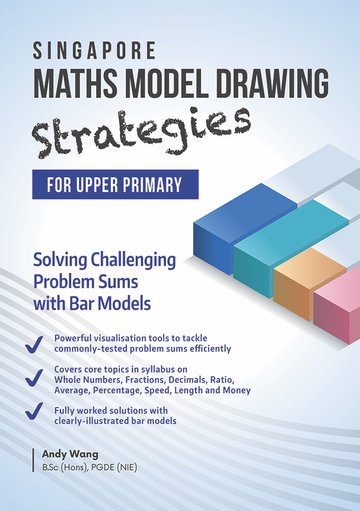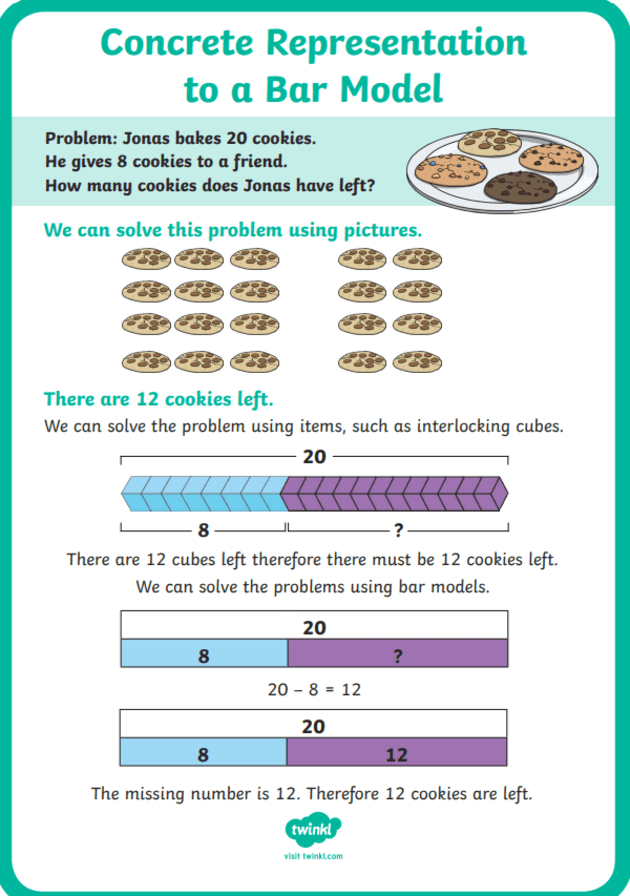Opening the Power of Bar Version Illustration Techniques for Effective Issue Addressing in Math
Bar model attracting methods use a distinct visual approach to maths that can improve analytical capacities. By streamlining complex partnerships and making abstract concepts much more easily accessible, these versions work as effective tools for learners. Nevertheless, the effectiveness of bar designs relies heavily on proper application. Understanding the essential concepts behind their usage can cause considerable enhancements in mathematical comprehension and communication. The question stays: how can teachers best integrate these strategies into their teaching strategies?
Comprehending Bar Versions: An Aesthetic Technique to Mathematics
Mathematics can frequently seem abstract and tough, bar models supply a visual strategy that simplifies problem-solving and boosts understanding. These models make use of rectangular bars to represent numbers and connections, making mathematical concepts extra concrete. By visually segmenting amounts, bar models enable pupils to much better grasp procedures such as enhancement, reproduction, division, and reduction.
When confronted with word issues, pupils can draw bars to stand for various aspects, assisting in the visualization of partnerships in between numbers. This technique not only aids in organizing details but likewise motivates abstract thought. As an example, in an issue including complete quantities, bar models can define wholes and components, making clear the called for computations. As trainees exercise with bar designs, they establish confidence in their mathematical capacities, allowing them to approach complex problems with an organized mindset - bar model drawing techniques. Bar models serve as an important device in the student's mathematical toolkit.
The Advantages of Utilizing Bar Versions in Trouble Addressing
When it comes to issue addressing in mathematics, bar versions offer various advantages. They offer a graph of numerical relationships, enabling students to conceive troubles more efficiently. By equating words right into bars, learners can break down complex scenarios right into manageable parts, thus promoting a more clear understanding of the trouble at hand.
In addition, bar versions advertise important thinking and logical abilities as students find out to manipulate the bars to find solutions. This aesthetic help helps in identifying patterns and relationships amongst numbers, making abstract principles more substantial. Moreover, bar versions improve interaction in mathematics, allowing pupils to verbalize their assumed solutions and processes clearly.

Just How to Produce Efficient Bar Designs
Developing effective bar versions calls for a systematic strategy that stresses clarity and precision. The initial step involves recognizing the trouble's crucial elements, including connections and quantities. Next off, one need to choose ideal devices for depiction, making certain proportionality among the bars. This help in picturing the connections much more accurately.
After determining the amounts, the design should be drawn, plainly identifying each bar to reflect its equivalent value. Making use of various shades can enhance understanding by comparing various aspects in the problem. It is likewise vital to keep constant spacing between bars, which assists prevent confusion.
When the design is created, confirming its precision through computations reinforces its performance. Exercising with a selection of problem types will enhance proficiency in producing bar versions. Ultimately, a properly designed bar model not just streamlines complex issues but also promotes much deeper understanding and analytic abilities in mathematics.
Bar Versions at work: Real-Life Examples
When applied to real-life circumstances, bar designs can properly illustrate complex connections and amounts, making them vital devices in various contexts. In budgeting, individuals can use bar models to aesthetically contrast revenue and expenses, assisting in determining excess or shortage. In a grocery buying situation, a bar version can stand for the price of various things, enabling customers to swiftly analyze complete investing and make educated choices.
In sporting activities, trains could utilize bar designs to assess gamer stats, such as points scored over a season, helping to determine performance trends. Additionally, in project management, bar models can illustrate task periods and source allowances, helping with more clear communication among employee. These examples demonstrate just how bar designs transcend academic limits, providing clarity in daily decision-making and improving understanding of quantitative connections in numerous areas.
Integrating Bar Models Into Class Understanding
Incorporating bar models right into classroom learning can greatly enhance trainees' ability to visualize mathematical principles. This approach not only help private understanding but likewise fosters joint discovering amongst peers. By collaborating to resolve troubles making use of bar models, trainees can create deeper understandings and reinforce their mathematical skills.
Visualizing Mathematical Principles
Bar versions serve as an effective device for picturing mathematical concepts in the class. By representing numbers and partnerships through bars, pupils acquire a more clear understanding click here of abstract concepts such as enhancement, division, subtraction, and reproduction. This visual help simplifies intricate issues, permitting learners to damage them into manageable components. Educators can properly show relationships in between quantities, making it simpler for trainees to comprehend principles like ratio, percentage, and portions. Bar versions likewise urge independent analytic, as trainees can adjust the aesthetic depiction to locate services. Incorporating these designs into lessons not only enhances pupil engagement yet additionally sustains different discovering designs, ensuring that all students can access and understand mathematical content better.
Encouraging Collaborative Understanding
Joint discovering can be substantially improved with making use of bar models in the class. By incorporating these aesthetic tools, educators can foster an atmosphere where pupils involve in group problem-solving, leveraging each various other's staminas. Bar models promote discussions, allowing students to express their believed processes and thinking clearly. This graph urges diverse strategies to deal with mathematical problems, promoting deeper understanding. Pupils can contrast their models, recognize inconsistencies, and collaboratively fine-tune their solutions (bar model drawing techniques). In addition, interacting with bar designs cultivates necessary abilities such as communication, critical reasoning, and team effort. Generally, incorporating bar models right into collective knowing not just strengthens mathematical comprehension yet also builds a helpful class society where students gain from one another

Usual Mistakes to Stay Clear Of When Utilizing Bar Versions
When trainees involve with bar designs, they frequently run into certain pitfalls that can impede their understanding of mathematical concepts. One common mistake is misstating the quantities included. Pupils may attract bars of unequal lengths to stand for equivalent values, leading to confusion. Additionally, falling short to identify benches plainly can lead to obscurity regarding what each bar represents. An additional frequent error is overlooking the relevance of scaling; trainees may fail to remember to keep proportionality, impacting the analysis of relationships in between numbers.
Some learners may hurry via the problem-solving process, ignoring to examine the trouble before drawing the model. This can cause improperly organized bars that do not represent the issue's requirements. Finally, students occasionally concentrate only on finishing the model without assessing the option, missing the chance to strengthen their understanding of the underlying mathematical concepts. Recognition of these errors can considerably improve the performance of bar design methods.
Encouraging Crucial Analyzing Bar Version Techniques
Bar designs advertise conversation and partnership among peers, as trainees share their interpretations and solutions. This exchange of concepts grows an important way of thinking, enabling students to analyze several strategies to an issue. Ultimately, integrating bar design strategies in maths education and learning not just boosts problem-solving capacities but likewise supports the essential thinking skills needed for scholastic success and real-world applications.
Regularly Asked Questions
Can Disallow Versions Be Used for Advanced Mathematical Concepts?
Bar designs can certainly be made use of for advanced mathematical ideas. They give visual representation and streamline complex issues, assisting in recognizing relationships and procedures. This technique enhances analytical abilities throughout various levels of mathematical effectiveness.
What Age Group Advantages Many From Bar Version Techniques?
Kids aged 7 to 12 advantage most from bar design strategies. This age team commonly battles with abstract ideas, and bar designs offer visual support, improving their understanding and analytical abilities in mathematics.
Are There Digital Tools for Creating Bar Models?
Yes, there are numerous electronic tools readily available for developing bar versions, consisting of software application like Google Drawings, Microsoft PowerPoint, and specialized academic applications designed for imagining mathematical ideas through bar modeling techniques efficiently.
Just How Do Bar Versions Compare to Various Other Visual Aids?
Bar designs offer a clear, organized representation of mathematical partnerships, often supplying advantages over various other visual help by streamlining complicated problems (bar model drawing techniques). Unlike pie graphes or graphs, they improve understanding via direct contrast and symmetrical representation
Can Prevent Versions Aid With Non-Mathematical Issue Resolving?
Bar versions can assist with non-mathematical trouble solving by aesthetically representing elements and relationships, streamlining intricate situations. Their structured strategy helps individuals assess troubles clearly, promoting far better decision-making and calculated reasoning in various contexts.
As students technique with bar versions, they develop self-confidence in their mathematical abilities, enabling them to come close to complex issues with an organized frame of mind. Furthermore, bar versions advertise critical thinking and analytical abilities as trainees find out to control the bars to locate solutions. Additionally, stopping working to classify the bars plainly can result in ambiguity regarding what each bar indicates. Bar models offer a clear, organized depiction of mathematical connections, frequently providing advantages over various other aesthetic aids by streamlining complex issues. Bar designs can help with non-mathematical trouble solving by visually representing connections and elements, streamlining complicated scenarios.